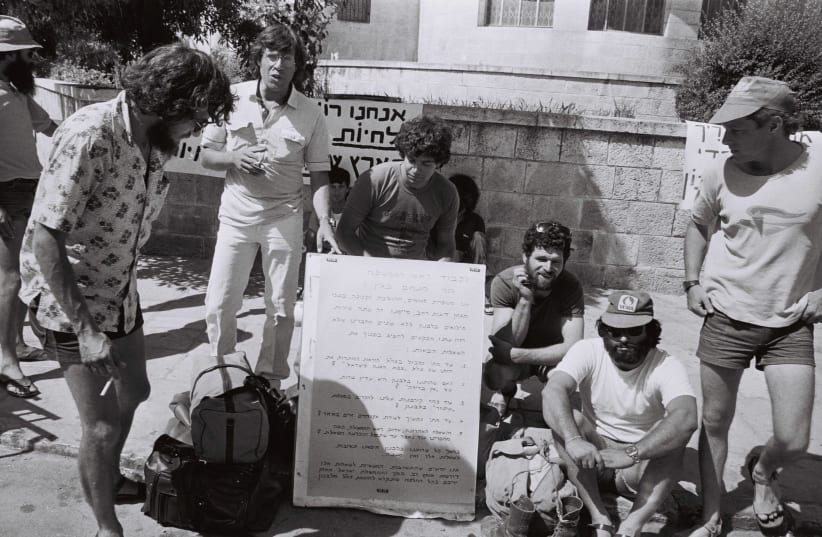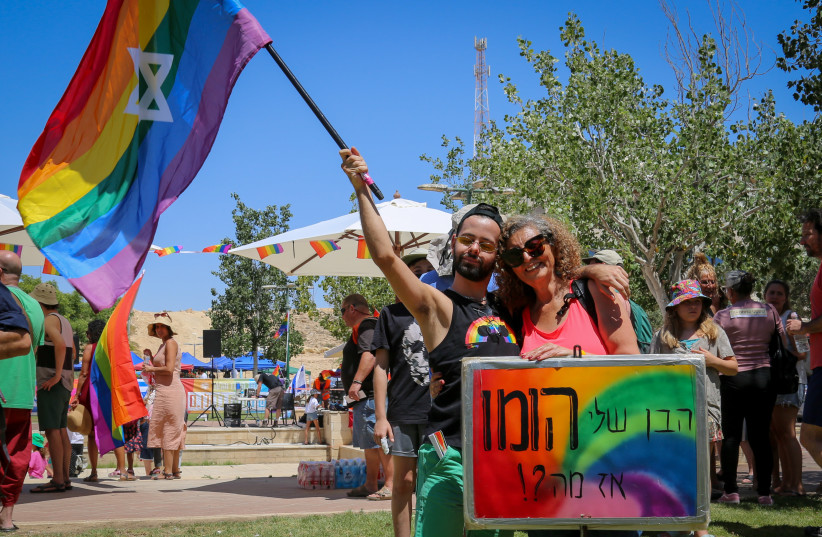To tell the truth, when asked about the Israeli Left, even I tend to get a bit confused.
On the one hand, it’s easy to get bogged down in pessimistic statistics and the fact that the Left is shrinking. The percentage of leftists who define themselves as being part of the Left has decreased over the years, as has the number of MKs who identify with the Left. Many of these people now prefer to self-identify as closer to the Center, as a way of avoiding being branded left-wing.
For more stories released for the 55th anniversary of the Six Day War, click here.
On the other hand, over the last three years, we’ve seen a level of democratic demonstrations here in Israel that hasn’t been seen in years, as every week hundreds of thousands of Israelis have taken to the streets in protest.
The Left lives
They stood on bridges overlooking highways and in throngs along Balfour Street, even as they were threatened by policemen and violently attacked by citizens with opposing political views. All of these protesters had one goal: To protect Israel’s democracy by removing Benjamin Netanyahu from power.
This task of bringing about a change of government in a democratic fashion and ending the tenure of the most powerful prime minister Israel has had for years, seemed so far out of reach. Bringing down Netanyahu, who served as prime minister even longer than Ben-Gurion did, was successful solely due to the mobilization of so many supporters.
The Israeli Left has not disappeared or weakened. It has changed its identity, undergone a rebranding and altered its priorities. The Left remains a leading force in Israeli society, which with the right flags could return to be a majority.
In the 1980s, over 400,000 Israelis protested against the Lebanon War. In the 1990s, great numbers of people supported the Oslo Accords and grieved over prime minister Yitzhak Rabin’s assassination. In the 2000s, giant protests against the rising cost-of-living were held, and in 2020s, there were the Balfour protests.
Israel’s liberal-progressive camp is alive and kicking. The fact that these formative and decisive events also took place is proof that the Left has not disappeared, it’s just undergone a change in perceptions. It’s been redefined, had a change in priorities and moved on in a new direction.
THE LEFT no longer goes by the term “Left.” Though it might have changed its priorities and the way it self-identifies, it is still present, strong and influential. The Balfour protests are the most tangible proof of this. Terms used by the Americans to differentiate between the Left and Right, such as progressivism and liberalism, better reflect the way the new Left self-identify here in Israel, too.
If we were to ask people who participated in these recent protests, who voted for political parties that were in opposition to Netanyahu, if they consider themselves leftists, most of them would say no. The reason is that currently, the Left has been labeled as radical, outdated and practically on the verge of being post-Zionistic and subversive.
Two external factors are responsible for the fact that people shy away from publicly stating they identify with the Left. The first one is the toxic discourse led by Netanyahu and the extreme right wing, whose devoted supporters over the years have altered the definition of the term “leftist,” giving it a more negative connotation, insinuating that anyone who identifies as leftist is betraying their country and collaborating with the enemy.
During the time he served as prime minister, he always managed to portray the Israeli Left as a terrifying demon, as a dangerous post-Zionistic, anti-Israel elite.
In this way, he intimidated potential constituents and rallied support for his so-called patriotic regime. He went to great efforts to misrepresent actions that were considered leftist by blackening the name of anyone who opposed him.
This tactic of Netanyahu’s – to present anyone whom he perceives as being against him as leftist – is not new. This was typical of his comportment in the era before the Rabin assassination, and also in more recent years, when he claimed that the media and Israel’s courts were in collusion with the Left.
There has always been, and always will be, an audience for this type of incitement. The joining of Kahanist supporters in recent years has only reinforced this trend of portraying the Left in such a negative light.
The second factor that dramatically contributed to the distancing of liberal Israelis from identifying with the Left is the dismal state of political negotiations with the Palestinians.
The failure of Camp David, the Second Intifada, the rise of Hamas, the fallout from the disengagement from the Gaza Strip, and over a decade during which the Israeli government has refused to support a two-state solution, have led to an impasse.
It’s impossible to promote pro-peace activism when a majority of the Israeli public does not consider the Palestinians to be a legitimate partner, and therefore does not believe that peace is a viable option.
In the absence of a political process, and there is no talk of the possibility of peace, we are left with discussions about occupation, human rights violations and the endless cycle of violence. On the Left, the voices supporting the advancement of the peace process have weakened, and have been replaced with voices in support of ending the occupation, human rights, criticism of Israel, the settlers and the IDF activity in the territories.
It’s only natural that when such critical messages – filled with self-blame – are expressed, the number of people who identify themselves with the Left would decline. Despite the immense importance of these matters, they receive little attention or support. When there’s no real chance of a breakthrough in political negotiations in the immediate future, and the Left limits its platform to condemning the occupation and the government, the number of Israelis who can identify with the Left’s goals becomes significantly reduced.
Where have they gone?
SO, WHERE have Israelis who support the Left disappeared to? Have they become centrists? Rightists?
Judging by the last election, the parties that self-identify as Center-Left and the Arab parties, received 48 seats. In comparison, in the 2015 election, the Left bloc, which included the Arab parties, received 53 seats. In other words, the decline was less dramatic that we may have thought.
Moreover, if you look at Israel’s current political map, the axis that separates the coalition from the opposition no longer moves according to antiquated definitions of Right and Left. Instead, it has recalibrated around Netanyahu and the values he represents. As a result, some Israelis who in the past might have self-identified as leftists are now voting for parties like the one led by Avigdor Liberman.
In recent polls, the number of people who identify as Center has risen, and the number of people who identify as left-wing has fallen. Fifty-eight percent of Israel’s Jewish population identifies as right-wing, 27 percent as Center and 15 percent as left-wing. Moreover, many of those who identify as left-wing have experienced a shift in their personal identity and ideology.
Studies carried out by the Geneva Initiative and Meretz show that people who classify themselves as left-wing are much more likely to identify as being secular, liberal and humanistic, and the importance of Judaism in their life is much lower.
Interestingly enough, however, the biggest change can be seen in people’s rating of importance regarding their ideological stance. The topic of the preservation of democracy moved into the top spot, replacing subjects like a Greater Israel and negotiations with the Palestinians. Democracy has now become the most popular value for people who self-identify as Left.
Topics such as gender equality, LGBTQ+ rights and the Arab community have moved into the first few slots, whereas topics like ending the occupation and achieving a peace settlement have become slightly less of a priority. The implication is that today’s Left is feeling a tangible threat to the fate of the country and its democratic character.
The opposition to violence carried out by settlers, for example, does not exist out of concern for the welfare of the Palestinians or the two-state solution, but out of fear that we may lose the values held dear by Israeli society. Many Israelis on the Left view the strengthening of the radical Right as a threat to their value system, much more than as a stumbling block to reaching an agreement with the Palestinians.
The study also shows that there has been a larger decrease in the degree of enthusiasm leftists are displaying toward reaching a peaceful solution, in comparison with rightists. The gap between men and women has remained constant, with more women displaying more flexibility vis-à-vis reaching a peaceful political agreement.
All of this data, including results from the last three rounds of elections, prove that the Left has not disappeared, it has simply altered its ideological identity. In the absence of an operative solution to the Palestinian conflict, peace issues have been pushed aside in favor of the deep need to protect Israel’s democracy from within, as was clearly demonstrated in the Balfour demonstrations.
Although the strengthening of the radical Right and fear of Netanyahu have reinforced these trends, a courageous leadership could lead us to a breakthrough on the topic of peace, which would be supported by the Israeli public.
Relinquishment of the annexation of territories as a prerequisite to the signing of the Abraham Accords is a reminder of the tremendous support a prime minister can receive when advocating for peace, even at the cost of relinquishing land. This is how it has always been, and how it will remain in the future. ■
The writer is a former director of Peace Now and placed 13th on the Meretz list in April 2019 election.
Translated by Hannah Hochner.


